Global Software-defined Anything (SDx) Market, By Offering, By Organization Size, By End User, By Region & Segmental Insights Trends and Forecast, 2024 – 2034
- Industry: Technology
- Report ID: TNR-110-1236
- Number of Pages: 420
- Table/Charts : Yes
- August, 2024
- Base Year : 2024
- No. of Companies : 10+
- No. of Countries : 29
- Views : 10071
- Covid Impact Covered: Yes
- War Impact Covered: Yes
- Formats : PDF, Excel, PPT
The software-defined anything (SDx) market is witnessing robust growth, driven by the increasing demand for flexible, scalable IT infrastructure. The shift towards cloud-based solutions and the need for network automation are key drivers, as organizations seek to optimize operations and reduce costs. Trends such as the integration of advanced security features and the rise of edge computing further enhance the market’s appeal.
Opportunities are abundant, particularly in sectors like IT, telecommunications, and BFSI, where digital transformation is accelerating. Additionally, emerging markets in Asia-Pacific and Latin America present significant growth potential, as businesses in these regions adopt SDx to stay competitive in an evolving technological landscape. In Terms of Revenue, the Global Software-defined Anything (SDx) Market was Worth US$ 39.6 Bn in 2023, Anticipated to Witness CAGR of 22.5% During 2024 – 2034.
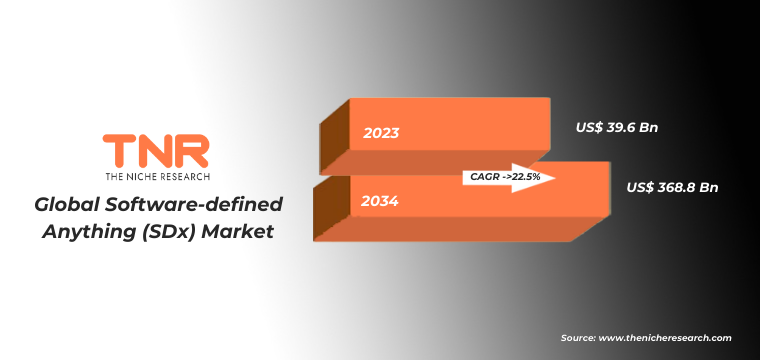
Trends in the Global Software-defined Anything (SDx) Market
- Integration of Advanced Security Features: With the increasing complexity and scale of IT infrastructure, organizations are prioritizing security within their SDx implementations. Software-defined Networking (SDN) and Software-defined Data Centers (SDDC) are now being equipped with enhanced security protocols, such as micro-segmentation, zero-trust architectures, and automated threat detection. This trend is driven by the growing prevalence of cyber threats and the need for real-time, adaptive security measures. As enterprises transition to more software-centric environments, the demand for robust, integrated security solutions within SDx will continue to rise, making it a key area of focus for vendors and service providers.
- Expansion of Edge Computing in SDx Solutions: As organizations seek to process data closer to the source for real-time analytics and decision-making, edge computing is becoming increasingly integrated with SDx solutions. This trend is particularly evident in industries like manufacturing, healthcare, and telecommunications, where latency and bandwidth constraints are critical. By leveraging Software-defined Networking (SDN) and Software-defined Storage (SDS) at the edge, companies can achieve greater efficiency and scalability while reducing the load on centralized data centers. The growing adoption of IoT and 5G technologies further accelerates this trend, positioning edge computing as a vital component of the future SDx landscape.
Solutions in the software-defined anything (SDx) market have emerged as a dominant force, capturing a significant revenue share of 78.8%. This dominance is attributed to the rising demand for integrated, software-driven infrastructure that enhances operational efficiency and scalability. Organizations across various industries are increasingly adopting SDx solutions, such as Software-defined Networking (SDN) and Software-defined Storage (SDS), to streamline their IT environments and reduce reliance on costly, proprietary hardware. The ability of these solutions to offer centralized control, automation, and flexibility has driven their widespread adoption. As digital transformation accelerates, the demand for SDx solutions is expected to grow, reinforcing their leading position in the market and driving further innovation.
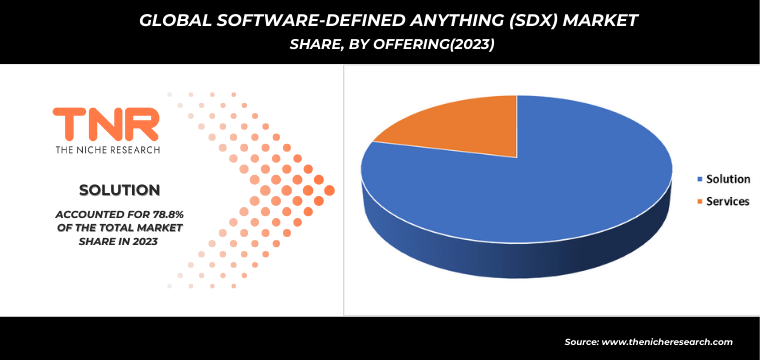
In 2023, the small and medium-sized enterprises (SMEs) segment secured its position as the second-largest category in the global software-defined anything (SDx) market. This growth is driven by SMEs increasingly adopting SDx solutions to enhance agility, reduce operational costs, and improve scalability. The flexibility and cost-effectiveness of SDx technologies, such as Software-defined networking (SDN) and Software-defined storage (SDS), appeal to SMEs looking to optimize their IT infrastructure without heavy investments in hardware. As these enterprises continue to digitize and modernize, their reliance on SDx solutions is expected to increase, solidifying their importance in the market.
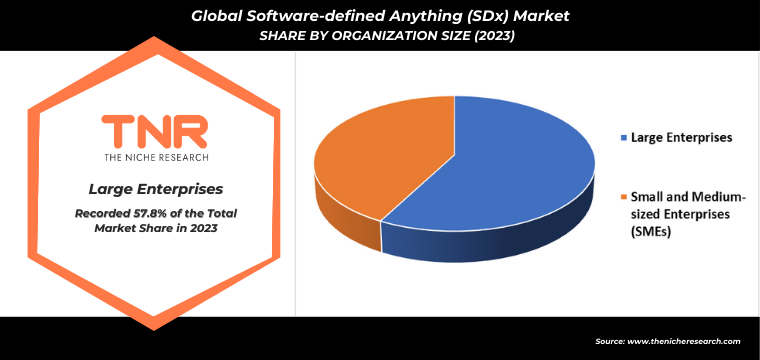
In 2023, the enterprises segment dominated the global software-defined anything (SDx) market, driven by large organizations’ increasing focus on digital transformation and IT infrastructure modernization. Enterprises are leveraging SDx solutions, including Software-defined Networking (SDN) and Software-defined Data Centers (SDDC), to achieve greater operational efficiency, scalability, and agility. These solutions enable centralized management, automation, and cost savings, making them highly attractive to large businesses with complex IT environments. The demand for enhanced security, real-time data processing, and seamless integration with cloud services further fuels the adoption of SDx among enterprises. As a result, the enterprises segment captured a significant market share, positioning itself as a key driver of growth in the SDx industry.
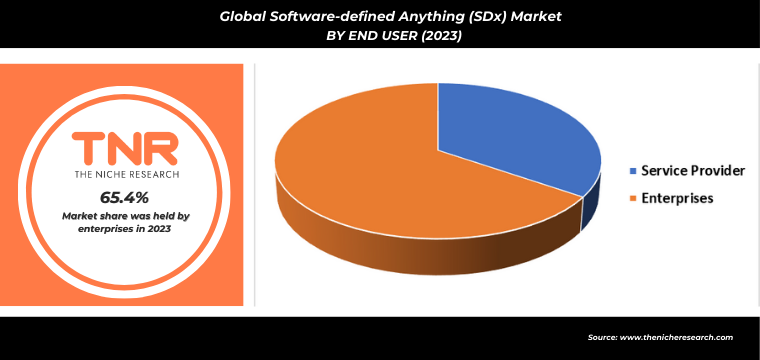
In 2023, North America solidified its dominance in the global software-defined anything (SDx) market, driven by strong adoption across key industries such as IT, telecommunications, and financial services. The region’s leadership in digital innovation, coupled with a robust IT infrastructure, has propelled the widespread implementation of SDx solutions. Major enterprises are increasingly investing in Software-defined Networking (SDN), Software-defined Storage (SDS), and other SDx technologies to enhance operational agility and reduce costs. Additionally, the presence of leading technology vendors and a high rate of cloud adoption further contributed to North America’s commanding market position, making it a pivotal region in the global SDx landscape.
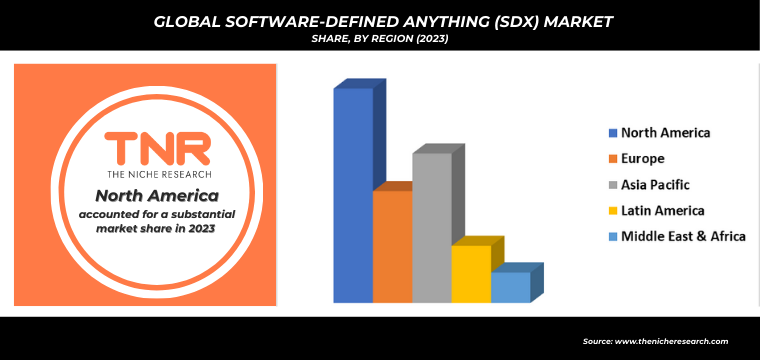
Competitive Landscape
Some of the players operating in the software-defined anything (SDx) market are
- Arista Networks Inc.
- Aryaka Networks Inc.
- Bigleaf Networks Inc.
- Cisco Systems Inc.
- Citrix Systems Inc.
- Dell Technologies Inc.
- Hewlett Packard Enterprise Development LP
- International Business Machines Corporation
- Juniper Networks Inc.
- Microsoft Corporation
- NEC Corporation (AT&T Corporation)
- NetApp Inc.
- VMware Inc.
- Other Industry Participants
Global Software-defined Anything (SDx) Market Scope
| Report Specifications | Details |
| Market Revenue in 2023 | US$ 39.6 Bn |
| Market Size Forecast by 2034 | US$ 368.8 Bn |
| Growth Rate (CAGR) | 22.5% |
| Historic Data | 2016 – 2022 |
| Base Year for Estimation | 2023 |
| Forecast Period | 2024 – 2034 |
| Report Inclusions | Market Size & Estimates, Market Dynamics, Competitive Scenario, Trends, Growth Factors, Market Determinants, Key Investment Segmentation, Product/Service/Solutions Benchmarking |
| Segments Covered | By Offering, By Organization Size, By End User, By Region |
| Regions Covered | North America, Europe, Asia Pacific, Middle East & Africa, Latin America |
| Countries Covered | U.S., Canada, Mexico, Rest of North America, France, The UK, Spain, Germany, Italy, Nordic Countries (Denmark, Finland, Iceland, Sweden, Norway), Benelux Union (Belgium, The Netherlands, Luxembourg), Rest of Europe, China, Japan, India, New Zealand, Australia, South Korea, Southeast Asia (Indonesia, Thailand, Malaysia, Singapore, Rest of Southeast Asia), Rest of Asia Pacific, Saudi Arabia, UAE, Egypt, Kuwait, South Africa, Rest of Middle East & Africa, Brazil, Argentina, Rest of Latin America |
| Key Players | Arista Networks Inc., Aryaka Networks Inc., Bigleaf Networks Inc., Cisco Systems Inc., Citrix Systems Inc., Dell Technologies Inc., Hewlett Packard Enterprise Development LP, International Business Machines Corporation, Juniper Networks Inc., Microsoft Corporation, NEC Corporation (AT&T Corporation), NetApp Inc., VMware Inc. |
| Customization Scope | Customization allows for the inclusion/modification of content pertaining to geographical regions, countries, and specific market segments. |
| Pricing & Procurement Options | Explore purchase options tailored to your specific research requirements |
| Contact Details | Consult With Our Expert
Japan (Toll-Free): +81 663-386-8111 South Korea (Toll-Free): +82-808- 703-126 Saudi Arabia (Toll-Free): +966 800-850-1643 United Kingdom: +44 753-710-5080 United States: +1 302-232-5106 E-mail: askanexpert@thenicheresearch.com
|
Global Software-defined Anything (SDx) Market
By Offering
- Solution
- Software-Defined Networking (SDN)
- Software-Defined Wide Area Network (SD-WAN)
- Software-Defined Data Center
- Software-Defined Computing (SDC)
- Software-Defined Storage (SDS)
- Software-Defined Data Center Networking (SDDCN)
- Services
- Professional
- Managed
By Organization Size
- Large Enterprises
- Small and Medium-sized Enterprises (SMEs)
By End User
- Service Provider
- Enterprises
- Banking, Financial Services, and Insurance (BFSI)
- Manufacturing
- Retail
- Healthcare
- Government
- Education
- Others
By Region
- North America (U.S., Canada, Mexico, Rest of North America)
- Europe (France, The UK, Spain, Germany, Italy, Nordic Countries (Denmark, Finland, Iceland, Sweden, Norway), Benelux Union (Belgium, The Netherlands, Luxembourg), Rest of Europe)
- Asia Pacific (China, Japan, India, New Zealand, Australia, South Korea, Southeast Asia (Indonesia, Thailand, Malaysia, Singapore, Rest of Southeast Asia), Rest of Asia Pacific)
- Middle East & Africa (Saudi Arabia, UAE, Egypt, Kuwait, South Africa, Rest of Middle East & Africa)
- Latin America (Brazil, Argentina, Rest of Latin America)
Report Layout:
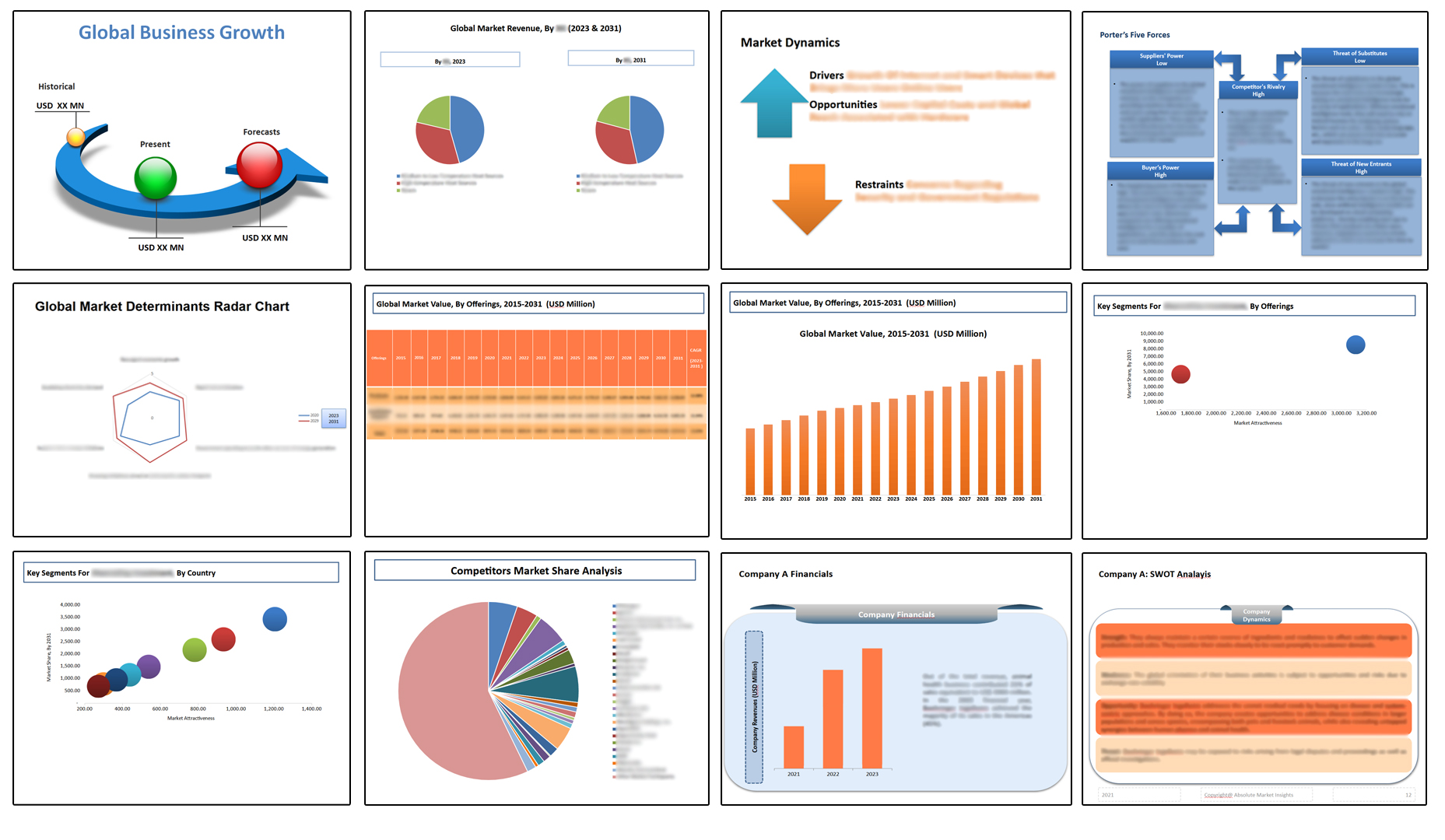
Table of Contents
Note: This ToC is tentative and can be changed according to the research study conducted during the course of report completion.
**Exclusive for Multi-User and Enterprise User.
Global Software-defined Anything (SDx) Market
By Offering
- Solution
- Software-Defined Networking (SDN)
- Software-Defined Wide Area Network (SD-WAN)
- Software-Defined Data Center
- Software-Defined Computing (SDC)
- Software-Defined Storage (SDS)
- Software-Defined Data Center Networking (SDDCN)
- Services
- Professional
- Managed
By Organization Size
- Large Enterprises
- Small and Medium-sized Enterprises (SMEs)
By End User
- Service Provider
- Enterprises
- Banking, Financial Services, and Insurance (BFSI)
- Manufacturing
- Retail
- Healthcare
- Government
- Education
- Others
By Region
- North America (U.S., Canada, Mexico, Rest of North America)
- Europe (France, The UK, Spain, Germany, Italy, Nordic Countries (Denmark, Finland, Iceland, Sweden, Norway), Benelux Union (Belgium, The Netherlands, Luxembourg), Rest of Europe)
- Asia Pacific (China, Japan, India, New Zealand, Australia, South Korea, Southeast Asia (Indonesia, Thailand, Malaysia, Singapore, Rest of Southeast Asia), Rest of Asia Pacific)
- Middle East & Africa (Saudi Arabia, UAE, Egypt, Kuwait, South Africa, Rest of Middle East & Africa)
- Latin America (Brazil, Argentina, Rest of Latin America)
The Niche Research approach encompasses both primary and secondary research methods to provide comprehensive insights. While primary research is the cornerstone of our studies, we also incorporate secondary research sources such as company annual reports, premium industry databases, press releases, industry journals, and white papers.
Within our primary research, we actively engage with various industry stakeholders, conducting paid interviews and surveys. Our meticulous analysis extends to every market participant in major countries, allowing us to thoroughly examine their portfolios, calculate market shares, and segment revenues.
Our data collection primarily focuses on individual countries within our research scope, enabling us to estimate regional market sizes. Typically, we employ a bottom-up approach, meticulously tracking trends in different countries. We analyze growth drivers, constraints, technological innovations, and opportunities for each country, ultimately arriving at regional figures.Our process begins by examining the growth prospects of each country. Building upon these insights, we project growth and trends for the entire region. Finally, we utilize our proprietary model to refine estimations and forecasts.
Our data validation standards are integral to ensuring the reliability and accuracy of our research findings. Here’s a breakdown of our data validation processes and the stakeholders we engage with during our primary research:
- Supply Side Analysis: We initiate a supply side analysis by directly contacting market participants, through telephonic interviews and questionnaires containing both open-ended and close-ended questions. We gather information on their portfolios, segment revenues, developments, and growth strategies.
- Demand Side Analysis: To gain insights into adoption trends and consumer preferences, we reach out to target customers and users (non-vendors). This information forms a vital part of the qualitative analysis section of our reports, covering market dynamics, adoption trends, consumer behavior, spending patterns, and other related aspects.
- Consultant Insights: We tap into the expertise of our partner consultants from around the world to obtain their unique viewpoints and perspectives. Their insights contribute to a well-rounded understanding of the markets under investigation.
- In-House Validation: To ensure data accuracy and reliability, we conduct cross-validation of data points and information through our in-house team of consultants and utilize advanced data modeling tools for thorough verification.
The forecasts we provide are based on a comprehensive assessment of various factors, including:
- Market Trends and Past Performance (Last Five Years): We accurately analyze market trends and performance data from preceding five years to identify historical patterns and understand the market’s evolution.
- Historical Performance and Growth of Market Participants: We assess the historical performance and growth trajectories of key market participants. This analysis provides insights into the competitive landscape and individual company strategies.
- Market Determinants Impact Analysis (Next Eight Years): We conduct a rigorous analysis of the factors that are projected to influence the market over the next eight years. This includes assessing both internal and external determinants that can shape market dynamics.
- Drivers and Challenges for the Forecast Period:Identify the factors expected to drive market growth during the forecast period, as well as the challenges that the industry may face. This analysis aids in deriving an accurate growth rate projection.
- New Acquisitions, Collaborations, or Partnerships: We keep a close watch on any new acquisitions, collaborations, or partnerships within the industry. These developments can have a significant impact on market dynamics and competitiveness.
- Macro and Micro Factors Analysis:A thorough examination of both macro-level factors (e.g., economic trends, regulatory changes) and micro-level factors (e.g., technological advancements, consumer preferences) that may influence the market during the forecast period.
- End-User Sentiment Analysis: To understand the market from the end-user perspective, we conduct sentiment analysis. This involves assessing the sentiment, preferences, and feedback of the end-users, which can provide valuable insights into market trends.
- Perspective of Primary Participants: Insights gathered directly from primary research participants play a crucial role in shaping our forecasts. Their perspectives and experiences provide valuable qualitative data.
- Year-on-Year Growth Trend: We utilize a year-on-year growth trend based on historical market growth and expected future trends. This helps in formulating our growth projections, aligning them with the market’s historical performance.
Research process adopted by TNR involves multiple stages, including data collection, validation, quality checks, and presentation. It’s crucial that the data and information we provide add value to your existing market understanding and expertise. We have also established partnerships with business consulting, research, and survey organizations across regions and globally to collaborate on regional analysis and data validation, ensuring the highest level of accuracy and reliability in our reports.









